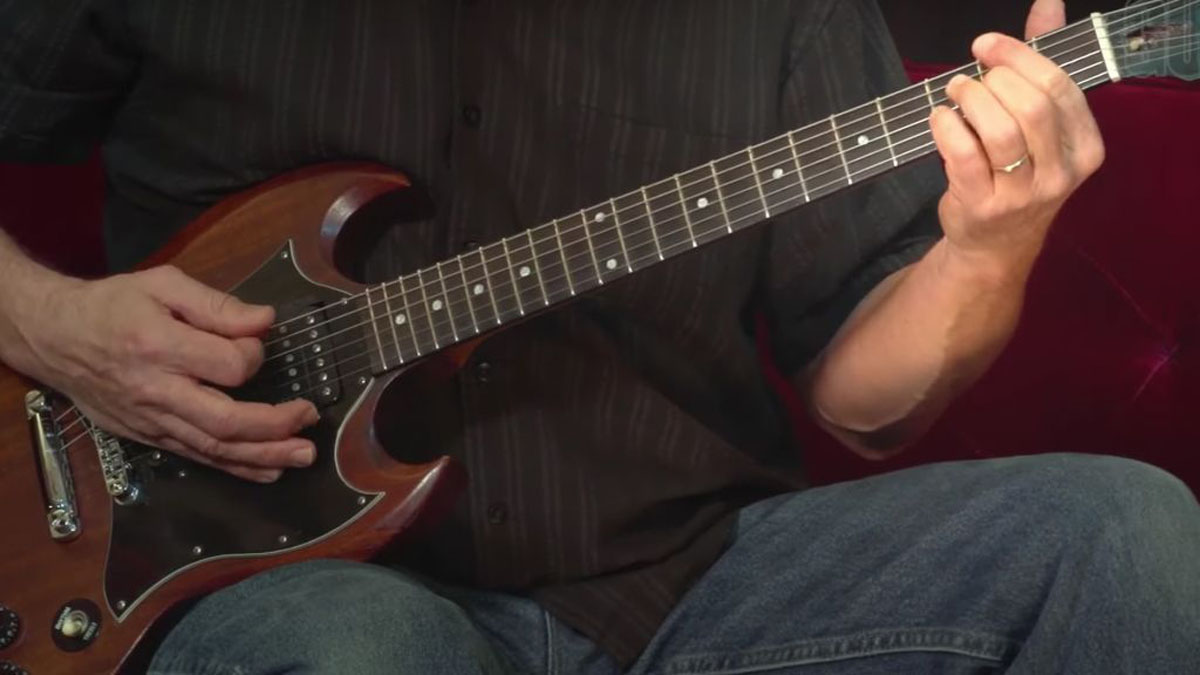How creating chains of dotted-eighth syncopations can revolutionize your rhythm playing
It's time to go against the grain with some tricky rhythmic phrasing

Last month, I presented a couple of interesting ways to apply accent patterns to a steady stream of 16th notes to create five- or six-note groups.
I then demonstrated how to chain those groups together to produce some rather tricky-sounding syncopations and rhythmic phrasing schemes that “go against the grain” of the expected four-note “quads.”
As you recall, I employed the very drum-like and musically effective “rhythm-within-a-rhythm” approach. I’d now like to present yet another cool and interesting way to phrase 16th notes – in groups of three, again by applying shifting accents. And with this pattern, we’ll learn about a highly useful and appealing rhythmic phrasing device known as dotted-eighth syncopations.
To begin, I’m going to play steady 16th notes entirely on the A string, using strict alternate picking and the open string as a rearticulated pedal tone and hitting the octave-higher A at the 12th fret on every third note, starting on beat 1 (see Figure 1).
The result is a highly syncopated “threes-on-fours” hemiola pattern with the naturally accentuated high A note “popping” at a different spot each time it’s played, relative to the beat.
As you can see, in 44 meter the pattern takes three bars to complete and come full circle, to the point where the fretted high A note finally falls on beat 1 again.
A highly beneficial exercise, or drill, is to practice running through this pattern repeatedly while counting the 16th-note subdivisions out loud and tapping your foot squarely on each beat. Doing so will definitely bolster your skills for playing and feeling rhythmically intense musical styles, such as prog rock, fusion, metal and funk.
All the latest guitar news, interviews, lessons, reviews, deals and more, direct to your inbox!
A cool thing you can do with this pattern is add a moving melody line with the fretted notes. In Figure 2, I’m additionally incorporating a sort of bluesy-Dorian-chromatic line that walks down the A string, skipping over certain notes, then back up again, using just enough notes – 16 – that the line lands on the starting high A each time you begin it again. (This line, by the way, brings to mind the double-time outro riff in the song B.Y.O.B. by System of a Down.)
Now, if we were to remove all the open A notes and instead hold each fretted note for the duration of three 16ths, we’re left with the rhythmically sparser but equally syncopated line shown in Figure 3.
This is an example of a dotted-eighth syncopation pattern. As you recall from a few lessons back, an augmentation dot placed to the right of a note indicates that its duration is increased by 50%. And so, in 44 meter, a dotted eighth note equals an eighth note tied to a 16th.
When crossing beats, however, you need to use a tie instead of a dotted eighth note, to show the breaks between the beats, per the rules of rhythmic notation. (This example, by the way, kind of reminds me of the super badass bass riff in Jungle Boogie by Kool & the Gang.)
As an additional exercise, play Figure 3 again, but now articulate each fretted note staccato, cutting it short after picking it, thus adding rests between the notes. Again, be sure to count and tap your foot as you play, to maximize the benefit of the drill.
Over the past 30 years, Jimmy Brown has built a reputation as one of the world's finest music educators, through his work as a transcriber and Senior Music Editor for Guitar World magazine and Lessons Editor for its sister publication, Guitar Player. In addition to these roles, Jimmy is also a busy working musician, performing regularly in the greater New York City area. Jimmy earned a Bachelor of Music degree in Jazz Studies and Performance and Music Management from William Paterson University in 1989. He is also an experienced private guitar teacher and an accomplished writer.




